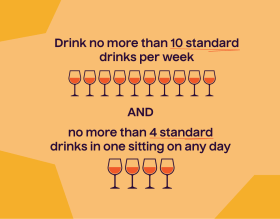
Long-term health effects
Long term alcohol use can cause damage to the body and increase the risk of cancer, liver disease, cardiovascular disease and stroke.
The National Health and Medical Research Council's Australian Alcohol Guidelines provide advice on how you can reduce health risks from drinking alcohol, based on the current scientific evidence.1
While there is no safe level of alcohol use, these Guidelines can help Australians to make informed decisions about how much alcohol they drink, if any.

To reduce the risk of harm from alcohol-related disease or injury, healthy men and women should drink no more than 10 standard drinks a week and no more than 4 standard drinks on any day.
By following this advice, there is a less than 1 in 100 chance of dying from an alcohol-related condition across your lifetime.
The less you drink, the lower your risk of harm from alcohol.

To reduce the risk of injury and other harms to health, children and young people under 18 years of age should not drink alcohol.

To prevent harm from alcohol to their unborn child, women who are pregnant or planning a pregnancy should not drink alcohol.
For women who are breastfeeding, not drinking alcohol is safest for their baby.
A standard drink is defined as 10 grams of pure alcohol. Many alcoholic drinks contain more than one ‘standard drink’.
The number of standard drinks varies depending on the type of alcohol and the size of the glass or container.
A standard drink might be less than you think. To find out more, visit the Standard Drink Tool.

Page last updated11 August 2023